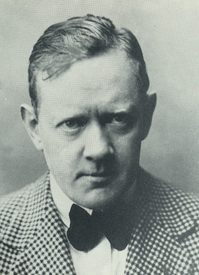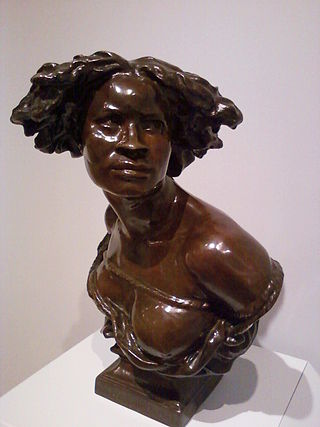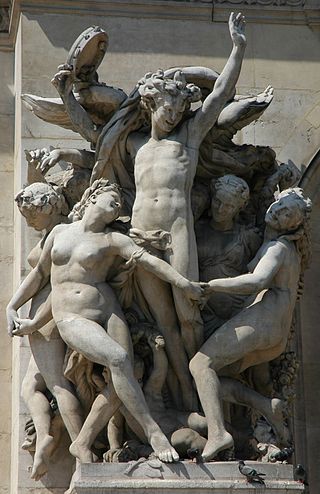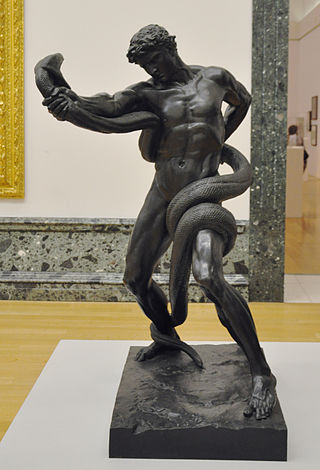
The Ny Carlsberg Glyptotek, commonly known simply as Glyptoteket, is an art museum in Copenhagen, Denmark. The collection represents the private art collection of Carl Jacobsen (1842–1914), the son of the founder of the Carlsberg Breweries.

Jean-Baptiste Carpeaux was a French sculptor and painter during the Second Empire under Napoleon III.
Events from the year 1868 in art.

Louis-Ernest Barrias was a French sculptor of the Beaux-Arts school. In 1865 Barrias won the Prix de Rome for study at the French Academy in Rome.

The Age of Bronze is a bronze statue by the French sculptor Auguste Rodin (1840–1917). The figure is of a life-size nude male, 72 in. (182.9 cm) high. Rodin continued to produce casts of the statue for several decades after it was modelled in 1876.

William Henry Rinehart was a noted American sculptor. He is considered "the last important American sculptor to work in the classical style."

The Fontaine de l'Observatoire is a monumental fountain located in the Jardin Marco Polo, south of the Jardin du Luxembourg in the 6th arrondissement of Paris, with sculpture by Jean-Baptiste Carpeaux. It was dedicated in 1874. It is also known as the Fontaine des Quatre-Parties-du-Monde, for the four parts of the world embodied by its female figures, or simply the Fontaine Carpeaux.

Joseph Alexis Bailly was an American sculptor who spent most of his career in Philadelphia, Pennsylvania. He taught briefly at the Pennsylvania Academy of the Fine Arts, which has a collection of his sculpture. His most famous work is the statue of George Washington in front of Independence Hall.

Kai Nielsen was a Danish sculptor.

A nasothek is a collection of sculpted noses.

The Negress is a bronze sculpture by French artist Jean-Baptiste Carpeaux. It is now in the permanent collection at the Indianapolis Museum of Art.The Negress was purchased by the Indianapolis Museum of Art in 1980.

Jean Gautherin was a French sculptor particularly known for his marble and bronze statues commissioned by the City of Paris.
Pierre Marie François Ogé was a French sculptor born in Saint-Brieuc on 24 March 1849 and who died in Paris on 5 June 1913.

La Danse is an 1868 sculpture by the French artist Jean-Baptiste Carpeaux. It was one of four sculptural groups made from Echaillon marble that decorate the façade of the Opera Garnier in Paris, two to either side of the entrance at ground level. The work was installed in 1869, and widely criticised as obscene. It was attacked in August 1869 when an anonymous vandal threw black ink over it. The scandal subsided after the outbreak of the Franco-Prussian War in 1870, and the original statue remained on the façade at the opera until it was transferred to the Louvre Museum in 1964 and replaced by a copy. The original was moved to the Musée d'Orsay in 1986.

Onésime-Aristide Croisy was a French sculptor. He is known for his dramatic bronze military statues, but perhaps best known for his marble Le Nid, showing two children asleep in an armchair.

Ugolino and His Sons is a marble sculpture of Ugolino made by Jean-Baptiste Carpeaux in Paris during the 1860s. It depicts the story of Ugolino from Dante's Inferno in which the 13th century count is imprisoned and starving with his children. The work, known for its expressive detail, launched Carpeaux's career.

An Athlete Wrestling with a Python was the first of three bronze sculptures produced by the British artist Frederic Leighton. Completed in 1877, the sculpture was a departure for Leighton, and heralded the advent of a new movement, New Sculpture, taking a realistic approach to classical models. It has been described as a "sculptural masterpiece" and as "possibly Leighton's greatest contribution to British art". Despite its indebtedness to the Classical tradition, it can be understood as one of the first stirrings of modern sculpture in Britain as well as in Europe. The Athlete was arguably the most influential piece of English sculpture of the 19th century.

The First Funeral is an 1878 plaster sculpture by Louis-Ernest Barrias, first exhibited at the Paris Salon that year, where it won a medal of honour. He then produced a marble version for the Salon of 1883. Both works show Adam and Eve bearing the body of their murdered son Abel. The plaster original is now in the Museum of Fine Arts of Lyon. The marble version is at the Ny Carlsberg Glyptotek, in Copenhagen.There is also a marble version at the Museo Nacional de Bellas Artes (MNBA) of Argentina. The sizes of this version are: 159 x 99 x 74cm.

The statue of Anders Sandøe Ørsted is located in Ørstedsparken in Copenhagen, Denmark. Ørsted was Denmark's leading jurist of the mid-19th century. He served as Prime Minister of Denmark in 1853–54.

















